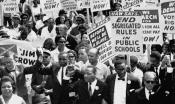text
Visual
Dr. Martin Luther King Marches on Washington

This photograph from the Associated Press shows Martin Luther King Jr. in a crowd of people at the March on Washington for Jobs and Freedom on Aug. 28, 1963.
July 2, 2014

